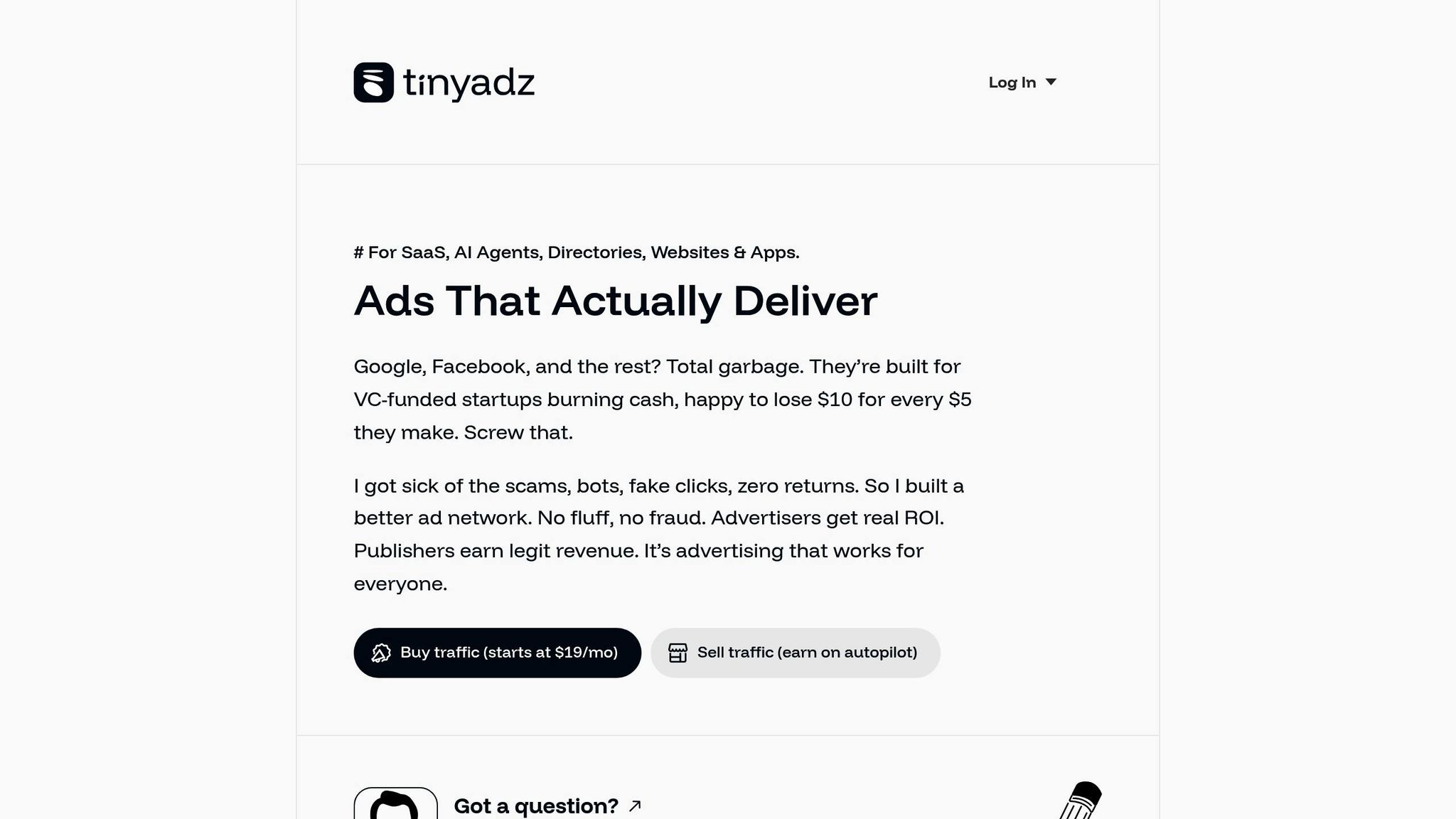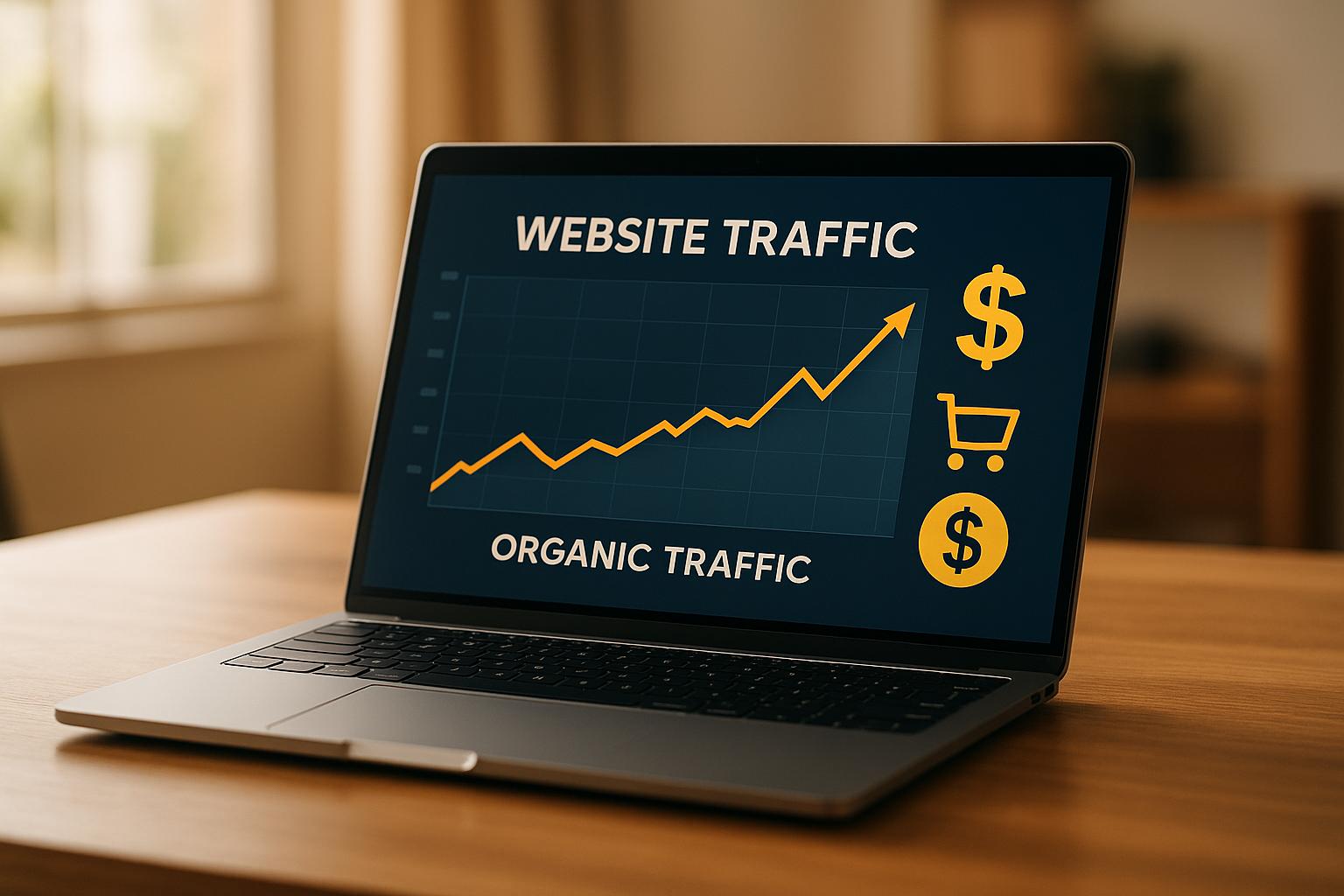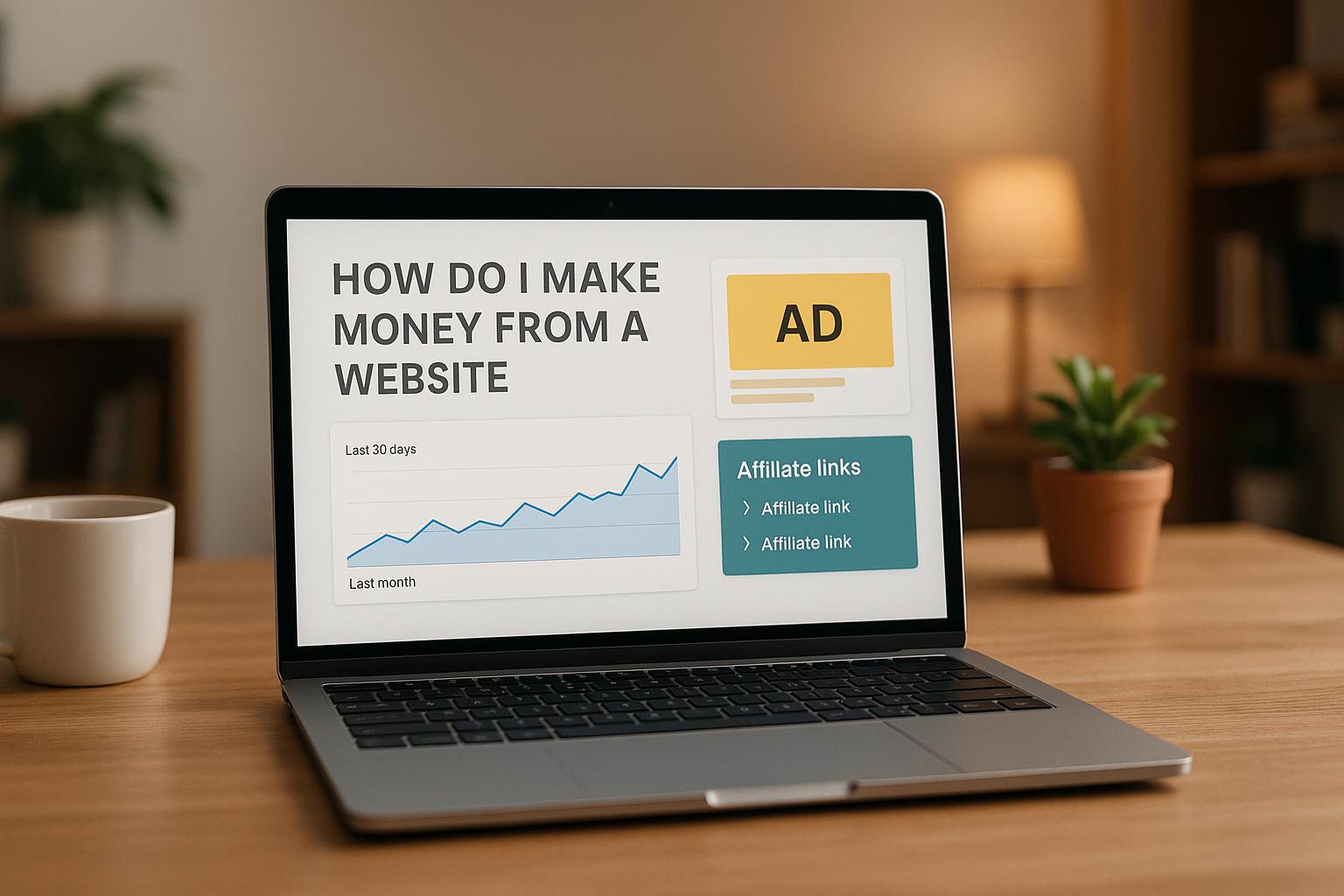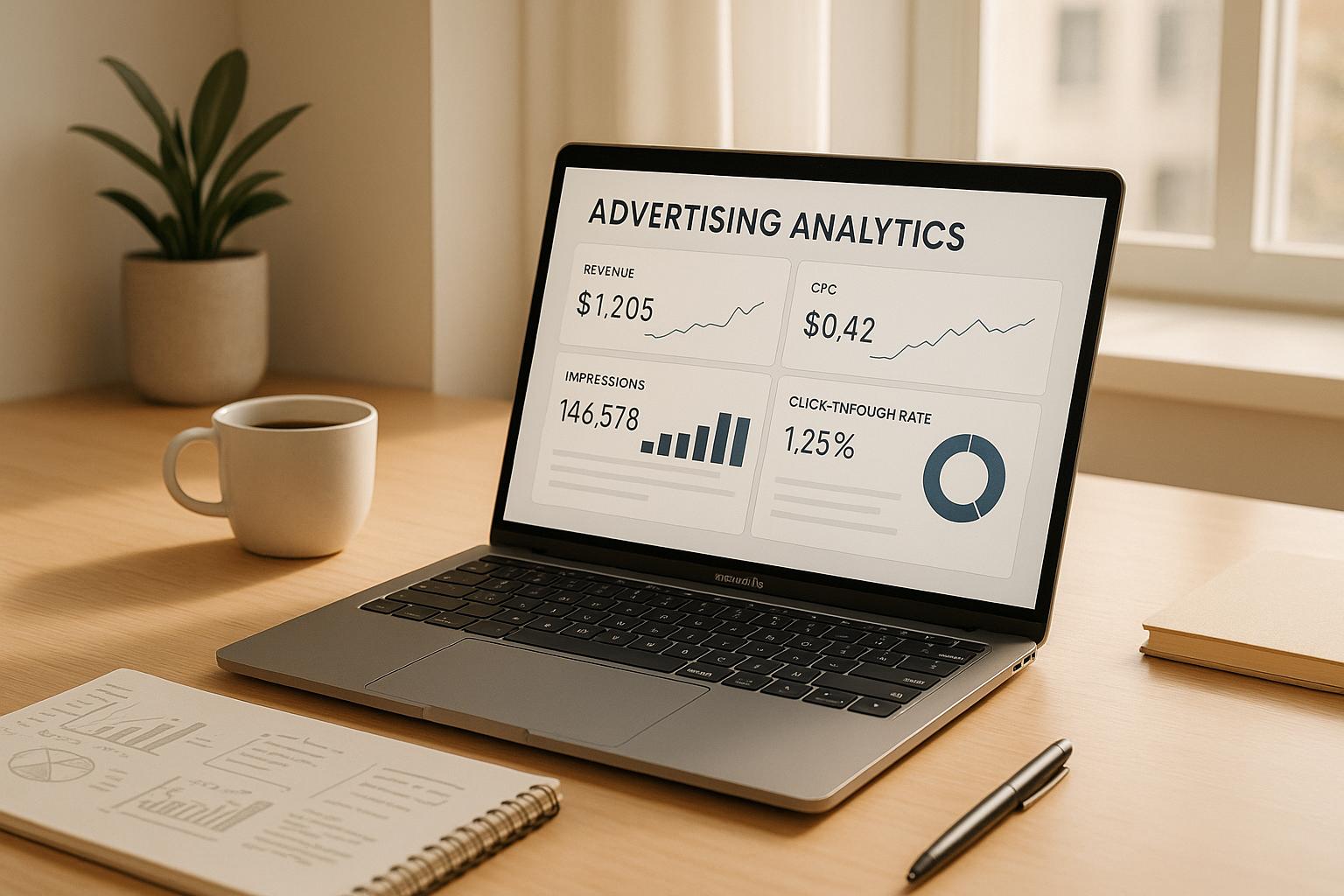Google AdSense might not be the best fit for everyone. Strict policies, low CPMs, and the need for high traffic make it challenging for many publishers. Plus, with ad blockers cutting into revenue and privacy regulations changing the game, it’s time to explore other monetization options.
Here’s a quick look at some alternatives:
- Affiliate Marketing: Earn commissions by promoting products your audience loves. High potential earnings if done right.
- Direct Ad Sales: Work directly with advertisers to keep all revenue and negotiate better rates.
- Native Advertising: Seamlessly integrate ads into your content for higher engagement.
- Subscription Models: Build a loyal audience and generate recurring revenue with paid memberships.
- TinyAdz: A platform for niche publishers to monetize with hyper-targeted ads.
Quick Comparison
| Method | Payout Threshold | Ease of Setup | Revenue Potential | Best For |
|---|---|---|---|---|
| Affiliate Marketing | Varies | Moderate | High | Blogs with engaged audiences |
| Direct Ad Sales | None | Difficult | Very High | High-traffic sites |
| Native Advertising | $50–$300 | Easy | Moderate to High | Sites looking for seamless ads |
| Subscription Models | None | Moderate | High | Unique content creators |
| TinyAdz | Contact for details | Easy | Niche-specific | Small, niche publishers |
Pro Tip: Don’t ditch AdSense entirely - combine it with these strategies to diversify your revenue streams and create a sustainable income.
Now, let’s dive into the details of each option and how to get started.
12 Highest Paying Adsense Alternatives in 2024
1. Affiliate Marketing
Affiliate marketing allows content creators to earn commissions by promoting products through unique tracking links. When a user clicks your link and makes a purchase, you get a percentage of the sale. In 2023, affiliate marketing spending in the U.S. hit $9.56 billion, with projections estimating it will grow to nearly $12 billion by 2025. According to Astute Analytics, this market could almost double by 2031, reaching close to $40 billion. This growth highlights affiliate marketing's potential to outperform traditional ad models by offering better conversion rates and revenue opportunities.
"Monetizing your website and earning money while you sleep is possible with affiliate marketing. This proven business model offers a convenient and flexible way to generate passive income without the headaches of customer support, product creation, or warehousing."
- monsterinsights.com
Revenue Potential
Affiliate marketing often outpaces traditional ad revenue. For instance, while AdSense typically pays $0.2 to $2.5 per 1,000 views, affiliate marketing can yield much higher earnings per conversion. A prime example is BloggersPassion.com, which earns over $10,000 per month through affiliate marketing alone, showcasing the power of targeted traffic.
Your earnings depend on factors like your niche, the products you promote, and the commission rates offered by affiliate programs. These rates can vary widely based on the program and market trends.
Audience Targeting Capabilities
Affiliate marketing thrives when promotions are tailored to specific audience needs. By understanding user behavior and preferences, publishers can align their efforts to deliver value, leading to better results. In fact, brands report 46% higher affiliate-based sales when collaborating with influencers and affiliates compared to traditional methods.
Creating detailed audience personas - focused on buying habits, online behavior, and preferred platforms - helps identify products your readers will connect with, boosting conversions and trust.
For example, YoloFoods leveraged impact.com’s Marketplace to diversify their affiliate partners, resulting in a 15% revenue increase. Similarly, FlowerChimp used performance data to reward top affiliates with better commission rates, driving a 55% rise in new customer acquisition.
Ease of Implementation
Starting with affiliate marketing is straightforward. Most programs, like ShareASale, CJ Affiliate, and ClickBank, provide tracking links, promotional materials, and analytics tools via user-friendly dashboards.
Publishers can choose products that align with their audience, create engaging content beyond simple product pitches, and optimize it for search engines to attract targeted traffic. Building an email list to share updates and exclusive affiliate offers can further enhance your strategy.
Affiliate marketing’s flexibility allows you to promote products across various channels - blog posts, social media, email campaigns, and video reviews - seamlessly integrating promotions into your content strategy.
Payout Thresholds
Affiliate programs generally follow one of three commission structures: Pay Per Sale (PPS), Pay Per Click (PPC), or Pay Per Lead (PPL). Each program has a minimum payout threshold, and payment cycles can range from weekly to monthly.
This flexibility lets publishers choose models that suit their content and audience. For instance, those with highly engaged followers might prefer PPS for higher per-conversion payouts, while websites with large traffic volumes may benefit from PPC for steady income streams.
2. Direct Ad Sales
For publishers exploring alternatives to Google AdSense, direct ad sales offer a promising path. This approach involves working directly with advertisers, cutting out intermediaries entirely. The result? Publishers keep all the revenue and can negotiate better rates.
Revenue Potential
Direct ad sales often outperform traditional ad networks because there’s no revenue sharing with middlemen. In fact, over 35% of small publishers rely on ad platforms to cover monthly expenses, and those who transition to direct sales frequently report higher earnings per impression.
Publishers have the freedom to negotiate pricing models such as CPM, CPC, CPA, or CPI. This flexibility allows them to secure rates that truly reflect the value of their audience. Blending multiple revenue models can also help create a more stable income stream. Offering perks like multi-month discounts or bundling ads with extras - like social media mentions or newsletter sponsorships - can make deals even more attractive to advertisers. Success here hinges on leveraging detailed insights about your audience.
Audience Targeting Capabilities
Understanding your audience inside and out is critical for thriving in direct ad sales. Personalized, data-driven targeting doesn’t just boost engagement - it can increase leads by over 120%. This gives publishers a strong case for commanding premium ad rates.
Building detailed audience profiles is key. Include demographic details, purchasing habits, social media activity, and engagement trends. The more specific and data-rich your audience insights are, the more valuable they’ll be to advertisers.
Ease of Implementation
While the revenue potential is exciting, effectively setting up a direct ad sales operation requires some groundwork. Start by creating an "Advertise" landing page and a media kit packed with audience data. Tools like Quantcast can help establish credibility.
Invest in a reliable ad server to manage and deliver ads efficiently. When pitching to advertisers, focus on the benefits you offer rather than just the features. Tailor your pitch to each advertiser and highlight past successes to build trust. Simple strategies, like adding "Advertise Here" banners to unused inventory, can also help generate leads as you grow your sales pipeline.
Payout Thresholds
One major advantage of direct ad sales is the control you gain over payment terms. You can negotiate schedules that match your cash flow needs. While monthly payments are common, some publishers secure weekly or even upfront payments for smaller campaigns. Transparent reporting is essential for building trust and ensuring timely payments.
Long-term success in direct ad sales depends on cultivating strong relationships. Consistent communication, honoring commitments, and optimizing ad performance - while prioritizing user experience - are all key to maintaining a thriving direct sales strategy.
3. Native Advertising Platforms
Native advertising has become a go-to solution for publishers aiming to balance user experience with revenue generation. These ads blend seamlessly with content, making them less intrusive and more engaging. In fact, users are three times more likely to click on native ads compared to traditional display ads. They also boast 40% higher engagement rates than standard display advertising.
Revenue Potential
Native ads don’t just engage users - they also justify higher pricing. With a 9% boost in brand affinity and 53% higher consumer engagement, they deliver results that allow publishers to charge premium rates. On average, native ads achieve a 0.80% click-through rate (CTR) and are 32% more shareable than display ads.
Real-world examples highlight their earning potential. REI’s Outdoor Community Initiative used native content in outdoor sports subreddits, creating activity-specific gear guides. By involving users in "Ask Me Anything" sessions, they achieved 4x higher CTRs than the platform average. Similarly, Xbox Game Pass’s Indie Game Campaign targeted niche gaming communities, collaborating with indie developers to create behind-the-scenes content, which led to a 2.5x subscriber growth in targeted segments.
Audience Targeting Capabilities
One of native advertising’s strongest features is its ability to target specific audiences. Platforms like Criteo and Amazon use demographic data and user behavior to connect advertisers with relevant audiences.
Reddit, in particular, excels at reaching niche communities. For example, Fenty Beauty partnered with LGBTQ+ creators in Reddit’s r/MakeupAddiction, producing tutorial content that highlighted inclusive shade ranges. This campaign achieved 3.2x higher engagement rates compared to traditional beauty ads. On the other hand, Dunkin’ Donuts used humor-driven memes tailored for subreddits like r/CollegeStudents and r/LateNightSnacks, earning 82% positive community sentiment. To succeed on platforms like Reddit, publishers should study subreddit culture, create content that aligns with community norms, and actively engage with feedback.
Ease of Implementation
The ease of implementing native ads varies by platform. Google Ad Manager offers flexible native ad formats that are simple to set up and scale, while also providing tools to track impressions, clicks, and revenue. Nativo, on the other hand, focuses on automation, enabling brands to publish sponsored content directly to high-quality sites while maintaining a consistent editorial style. However, some networks may require manual setup, which can be more time-intensive.
For the best results, publishers should prioritize platforms with user-friendly interfaces and seamless integration into their existing systems. Testing multiple platforms and comparing their performance can help find the right fit. Ensure that native ads align with your site’s design to maintain a smooth user experience.
Here are some native advertising strategies based on specific goals:
| Goal | Recommended Native Unit | Why It Works | Example |
|---|---|---|---|
| Boost Engagement | In-Feed Ads | Blends naturally into the user's journey, encouraging more interaction without feeling intrusive. | A sustainable living blog promoting eco-friendly products within article suggestions. |
| Increase Page Views | Recommendation Widgets | Guides users to additional content, keeping them on your site longer. | A news site recommending related stories, combining editorial content with sponsored links. |
| Offer Premium Ad Experiences | Custom Content | Creates high-value campaigns that strengthen advertiser partnerships. | A fitness site partnering with a sports brand to build an interactive workout guide featuring branded products. |
| Build Brand Trust | Sponsored Content | Allows advertisers to share long-form, valuable content that aligns with audience interests. | A finance website publishing a sponsored article on managing debt by a credit counseling service. |
Payout Thresholds
Native advertising platforms often provide more favorable payout thresholds than Google AdSense’s $100 minimum. For instance, Nativo, TripleLift, and RevContent have a $50 minimum, making it easier for smaller publishers to receive payments more regularly. Meanwhile, MGID and Taboola maintain the same $100 threshold as AdSense.
Payment timing also varies. Taboola, for example, pays 45 days after the end of the earnings month, while other platforms may offer faster cycles. For publishers with lower traffic, choosing platforms with lower payout thresholds can ensure steadier cash flow.
When evaluating platforms, consider their payment methods and any associated fees. Some offer multiple options, like PayPal, wire transfers, or checks, but processing fees may impact your final earnings.
sbb-itb-957fd63
4. Subscription and Membership Models
Subscription and membership models give publishers a direct connection to their audience while providing a steady stream of income. On average, Americans now spend $219 per month on subscriptions, showcasing how deeply embedded this model has become in consumer habits. For publishers, this approach offers a practical alternative to traditional ad revenue sources like Google AdSense.
Memberships focus on creating a sense of community by offering exclusive perks, while subscriptions emphasize consistent value delivery. These distinctions shape how publishers design their offerings and engage with their audience.
Revenue Potential
The subscription e-commerce market was projected to surpass $38 billion in revenue by the end of 2023 - more than double its size in 2019. For established publishers, the financial outlook is even brighter. Nearly half (45.2%) of established membership-based businesses report earning six figures annually, and 63.5% have experienced income growth over the past year.
One of the key benefits of subscription models is their ability to generate predictable, recurring revenue while boosting customer lifetime value.
Real-world examples highlight the variety of pricing strategies publishers can adopt. For instance, The Richland Source offers five membership tiers, starting with a $70 annual Starter Membership and going up to the $1,000 annual Sustainer Membership. Similarly, Good Morning Wilton provides three options: GMW Member ($60 annually), GMW Neighbor ($120 annually), and GMW Warrior ($240 annually). The Appen Press Club takes a monthly approach with three pricing levels - $13, $21, and $42 per month - and includes an annual plan that grants free access to all Press Club events.
Audience Targeting Capabilities
Subscription models excel at building engaged communities by focusing on subscribers who are genuinely committed. This allows publishers to deliver highly personalized experiences tailored to subscriber preferences and behavior. Understanding what members value most is crucial for fostering loyalty and minimizing churn.
"We discovered members had different perspectives about the value of local news. Some believe a healthy local news organization means strong accountability reporting. Others view it through a personal lens because we've reported on a cause that's dear to them, and they want to support it."
- Jay Allred, president and publisher, The Richland Source
Ease of Implementation
Launching a subscription model starts with defining a clear value proposition that goes beyond what’s available for free. Having the right tools - such as CRM systems, billing platforms, and data analytics - ensures smooth operations. Before fully committing, publishers can test pilot programs to gauge interest and refine their offering. Transparency is also key: clear terms of service and easy cancellation policies help build trust with subscribers. With these elements in place, publishers can set up a system that delivers consistent and flexible revenue.
Payout and Payment Flexibility
Subscription models simplify the payment process, offering regular and predictable income without relying on ad network thresholds. Many platforms also provide flexible billing options, like pause features and localized pricing, which can improve retention and resolve payment issues. By managing payments directly, publishers reduce their dependence on third-party networks that may impose unfavorable payout terms or delays.
5. TinyAdz

TinyAdz stands out by offering niche publishers a unique way to monetize their platforms. It connects publishers with advertisers who value highly specific, authentic audiences. By focusing on targeted reach, TinyAdz helps publishers tap into their audience's full potential.
Revenue Potential
TinyAdz uses a personalized matchmaking system to help publishers maximize earnings while ensuring advertisers see strong returns on investment. Beyond standard banner ads, the platform supports various revenue streams, including directory listings, social media promotions, newsletters, and event-based monetization. These options allow publishers to diversify their income across multiple content formats. With campaigns that guarantee 100% verified human impressions, TinyAdz prioritizes audience trust and engagement. Their targeted advertising ensures ads reach the right people, boosting overall campaign effectiveness.
Audience Targeting Capabilities
What sets TinyAdz apart is its ability to connect advertisers with genuine users on niche platforms. Publishers can display ads tailored to their specific audience, making the content feel more relevant and increasing click-through rates. This precise targeting is designed to improve both engagement and campaign performance.
Ease of Implementation
TinyAdz makes getting started simple. Publishers can sign up quickly, with no traffic minimums required. The platform offers flexible monetization options, allowing publishers to choose strategies that align with their content and audience. Additionally, TinyAdz provides responsive support through LinkedIn, Twitter, and email, ensuring publishers have access to assistance whenever needed.
Payout Thresholds
TinyAdz doesn’t publicly share its payout thresholds. Publishers interested in specific payout details are encouraged to ask during the sign-up process for more information.
Comparison: Pros and Cons
Here's a quick look at the pros and cons of different monetization methods. This breakdown highlights the trade-offs to help you decide what fits your goals best.
| Monetization Method | Payout Threshold | Ease of Implementation | Revenue Potential | Audience Targeting | Best For |
|---|---|---|---|---|---|
| Affiliate Marketing | Varies by program | Moderate – requires content integration | High for relevant products | Self-directed based on content | Publishers with engaged, purchase-ready audiences |
| Direct Ad Sales | None (invoice-based) | Difficult – requires sales skills | Very high with the right clients | Complete control over advertiser selection | Established sites with significant traffic |
| Native Advertising | $50–$300 | Easy – simple code integration | Moderate to high | Platform-dependent targeting options | Publishers seeking seamless ad integration |
| Subscription Models | None (recurring) | Moderate – requires a premium content strategy | High with a loyal audience | Direct relationship with subscribers | Content creators with unique, valuable offerings |
| TinyAdz | Contact for details | Easy – no traffic minimums | Personalized based on niche | Hyper-targeted niche matching | Niche publishers seeking authentic audience connections |
Let’s break this down further to better understand the strengths and challenges of each method.
Affiliate marketing can deliver strong earnings, but success hinges on aligning products with your audience's needs and maintaining their trust. It’s a great fit for publishers who know their audience well and can create compelling product content.
Direct ad sales offer the potential for significant revenue since you cut out intermediaries. However, it involves substantial effort - finding advertisers, negotiating deals, and managing relationships. This method is best suited for publishers with a steady stream of traffic and a knack for sales.
Native advertising blends seamlessly with content, which makes it more engaging than traditional ads. Platforms like Nativo, TripleLift, and RevContent have low payout thresholds, starting at $50, making them accessible for smaller publishers. Others like MGID and Taboola require $100 minimum payouts, while BidVertiser demands a $300 deposit to get started. Research shows native ads are 53% more effective at grabbing attention than display ads. The challenge? Striking the right balance between ad placement and user experience.
Subscription models eliminate payout thresholds entirely by offering recurring revenue. The catch is ensuring your content consistently delivers enough value to justify the cost. This works well for creators offering exclusive insights, tools, or community perks.
TinyAdz offers a unique approach by skipping traffic minimums and focusing on matching niche publishers with hyper-targeted audiences. While payout specifics aren’t widely shared, its emphasis on verified impressions and personalized connections makes it a solid option for niche publishers.
Many publishers find success by combining methods. For example, pairing affiliate marketing with native ads or supplementing subscription revenue with targeted ad placements can spread risk and maximize income. Experiment with different approaches and keep a close eye on performance metrics to find the right mix for your audience.
Conclusion
Switching away from Google AdSense doesn’t have to feel overwhelming if you approach it with a clear plan. The key is understanding your audience - this is the backbone of any successful monetization strategy. Different platforms and niches naturally attract different audience sizes and engagement levels, so it’s essential to dig into your traffic patterns, engagement metrics, and audience demographics before making any big moves. This groundwork will help you layer new monetization methods effectively over time.
Instead of scrapping AdSense entirely, think about adding other monetization options alongside it. The creator economy is on track to grow from $250 billion in 2023 to $480 billion by 2027, opening up massive opportunities for publishers who adapt wisely. Similarly, the AVOD market is projected to hit $66 billion by 2026 - a 144% jump from 2020. These numbers highlight the growth potential for those ready to take advantage of the shifting landscape.
Testing and tweaking your approach is crucial. What works for one publisher could flop for another, even in the same niche. Start with one new method, monitor your performance metrics closely, and scale up what delivers the best results.
Above all, keep your audience’s experience front and center. Monetization should enhance, not disrupt, the user experience. For instance, native ads tend to perform well because they blend naturally with content, while poorly executed direct ad sales can push visitors away. Keep an eye on bounce rates, page speed, and user feedback as you roll out changes.
If you’re a niche publisher, platforms like TinyAdz can be a game-changer, offering solutions without traffic minimums and focusing on meaningful audience connections.
FAQs
What should publishers keep in mind when deciding between monetization methods like affiliate marketing, direct ad sales, or subscription models?
When deciding on monetization strategies, publishers need to prioritize their business objectives, audience needs, and overall user experience. For instance, affiliate marketing can be a great fit for serving niche audiences, while subscription models may work better for those offering exclusive, high-value content.
Key considerations include potential revenue, ease of setup, and adherence to privacy laws. Striking the right balance between generating income and providing a seamless, enjoyable experience for your audience is crucial. Plus, any monetization method should align with your content focus and the specific demands of your industry.
What are the best ways for publishers to combine multiple monetization strategies without negatively affecting user experience?
To effectively combine various monetization strategies, publishers need to strike a balance between generating revenue and maintaining a positive user experience. The first step is understanding your audience - what they value, how they engage with your content, and what motivates them to stay. For example, you might use display ads for users accessing free content, while reserving premium articles or subscription plans for your most loyal and engaged readers.
You can also explore additional revenue streams like native advertising, affiliate marketing, or even token-gated content. These options not only diversify your income but also allow you to cater to different audience segments. Use analytics tools and A/B testing to evaluate how each strategy performs. This data will help you fine-tune your approach so that your monetization methods integrate smoothly into the user experience.
The goal is to make these efforts feel natural and beneficial, not intrusive. Regularly review your data and adjust your strategies to maintain the perfect balance between profitability and user satisfaction.
What are the pros and cons of switching from Google AdSense to alternatives like native advertising or subscription models?
Switching from Google AdSense to options like native advertising or subscription models can open up new opportunities, but each comes with its own set of challenges and benefits. Native advertising integrates ads into your content in a way that feels natural, leading to higher engagement since the ads don’t feel disruptive. The downside? It takes time and effort to fine-tune these campaigns for maximum effectiveness.
On the flip side, subscription models can provide a more reliable income stream. With subscribers paying regularly, you can count on consistent revenue. But there’s a catch - this approach requires top-notch, exclusive content that justifies the cost. Plus, convincing people to pay for content when they’re used to getting it for free can be a tough sell.
In short, native ads are great for keeping your audience engaged, while subscription models are better suited for publishers who have a loyal fanbase and premium content to offer. Weigh your audience’s habits and your ability to commit resources before choosing the best path forward.


